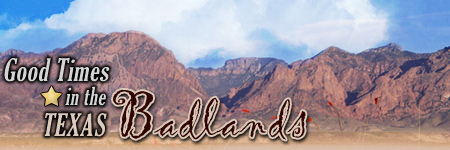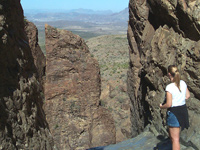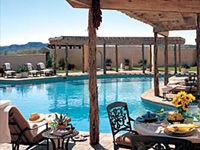
Explore the Natural Wonder Badlands in Texas
by
Lisa Anderson Mann
The
scenery -- millions of acres stretching to the horizon --
is rugged, stark and beautiful. Somewhere between here and
the horizon, the United States ends and Mexico begins.
If
you're hearing the call of the open road, and you're leaning
toward something wide open, the far southwestern corner of
Texas could be the road trip you're looking for. Big Bend
(named after the huge U-turn the Rio Grande makes here) is
truly remote.
It
is 100 miles to the nearest interstate highway, 608 miles
from Dallas, 350 miles from El Paso, and 244 miles to Odessa/Midland.
Until relatively recently, high school students in the Terlingua/Lajitas
area bused 89 miles each way to school.
 |
|
A
serene outlook compensates a hike through the Chisos
mountains |
Here
in the land of Black Jack Pershing, Pancho Villa and the Comanche
Indians, it's possible for one to play out every childhood
cowboy fantasy: Horseback ride a couple of hours to an ocotillo-studded
mesa, or take several days to ride through northern Mexico;
raft lazily down the Rio Grande or pull your own weight paddling
a canoe; take a jeep through the isolated Chihuahua desert
or hike the trails of the stunning Chisos mountains; hunt
for quail or fossils; count the stars or learn "Cowboy
Action Shooting."
Big
Bend National Park is the regions big draw, covering some
800,000 acres that include the Chisos Mountains, huge Chihuahuan
Desert basins, magnificent canyons and the Rio Grande River.
Towns are few and far between in this part of Texas. Terlingua
and Study Butte are old quicksilver mining towns, still retaining
the air of ghost towns, but boasting services, including a
renowned chili cook-off, and a surprisingly robust music scene.
Marathon is a historic ranching community that has become
the northern gateway to the Big Bend region.
Texas
businessman Steve Smith, lured by an ad in Millionaire Magazine,
bought the ramshackle town of Lajitas at an auction in 2000.
At the time, Lajitas consisted of a low-end motel, a nine-hole
golf course, a fake old west-style boardwalk, an RV park,
a deteriorating gravel runway, canoe access to a neighboring
Mexican village of Paso Lajitas, and a beer-drinking goat
named Clay Henry that was also the towns elected mayor.
Things have changed. Smith has invested millions of dollars to build a world-class resort. (The original Clay Henry has died, but a new beer-drinking goat, Clay Henry III is the current elected mayor.)
 |
Lajitas resort, an "Ultimate Hideout", has plenty of accommodations |
Lajitas Resort, which bills itself as the Ultimate Hideout, offers the oxymoronic promise of rugged luxury. The resort now has two restaurants, a spa, hunting lodge, equestrian center, tennis courts and an airport for private jets. Lajitas Resort's championship Bechtol-Russle course has 19 holes; hole 11a is an optional par one that that plays into Mexico that lets players shoot straight across the Rio Grande to a south-of-the-border green 110 yards away. (Since there's no border crossing within 100 miles, and therefore no way to putt out, the green has slightly concave surface to encourage a Mexican hole-in-one from the U.S.)
Golf, massage and fine dinning may be beguiling, but it's the scenery that is most bewitching. Some of the Lone Star State's most scenic drives traverse the Big Bend area, offering wide, sweeping views of west Texas' dramatic, rugged terrain. Some of the roads are paved, but far more suitable only for four-wheel drive vehicles. Big Bend National Park alone offers more than 150 miles of unpaved roads.
Strangely savage, magnificently isolated, and Texas-sized huge, the vistas that seem at first merely desolate and dry show a different sight in every light and every season. The siren song of the open road is sure to lead you here again and again.
|